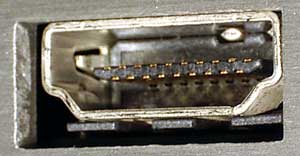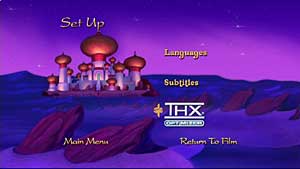Some time back I mentioned the aspect ratio limitations of the DVD+VR recording format, as used by consumer DVD+R/RW DVD recorders. I took the opportunity to draw this to the attention of Philips Electronics — the inventor and controller of DVD+VR and DVD+R/RW technology, and shortly before I went overseas, received a reply. It is one that I consider very disappointing. Before getting to it, here’s the issue.
Each Title on a DVD (whether commercially available pre-recorded ones, or made on a recorder) is marked with the aspect ratio of the content of that Title. The two principal alternatives are 16:9 or 4:3. This item of information is very important to DVD players, because it affects how the DVD player delivers the picture to the TV. Remember, in the DVD player’s setup menu you have to specify your TV’s aspect ratio. Specify it incorrectly, and the picture will be distorted. The following table shows the effect that this setting has upon the picture, depending upon the ‘flag’ marking the aspect ratio for the particular Title.
| |
|
Display Device Aspect Ratio |
| |
|
4:3 |
16:9 |
| DVD Title Aspect Ratio |
4:3 |
Picture unaltered |
Picture unaltered* |
| 16:9 |
Vertical height of picture reduced from 576 to 432 pixels (PAL), or from 480 to 360 (NTSC)** |
Picture unaltered |
* A few DVD players will reformat the picture by shrinking the picture width by 25% and inserting black bars to either side. Most rely on the display device to adjust for the narrower picture.
**Some DVDs will be reformatted, if the DVD player is set to ‘4:3 pan and scan’ rather than ‘4:3 letterbox’, by cropping a central portion from the widescreen image. But DVDs so encoded remain rare.
Notice that in only one of the four combinations is the picture reformatted: when it’s an anamorphic widescreen picture (ie. 16:9 format) being shown on a 4:3 TV. If it were not reformatted, then the image would seem tall and narrow. The reformatting is performed in one of two ways: either omitting every fourth horizontal scan line (the cheap and nasty way), or by generating three new scan lines from each group of four source ones (producing a somewhat smoother result).
But here’s the problem: if the DVD player does not know that the source picture is in 16:9 format, then it will not reformat it for a 4:3 TV. And there is no way of forcing the image to display correctly (except for those few 4:3 TVs that also have a 16:9 display mode).
Consumer DVD+R/+RW recorders alway record everything with the Title aspect ratio flag set to 4:3. Instead, the aspect ratio of the source is flagged within the video stream under the DVD+VR specification. But this is a proprietary flag, recognised only by DVD+R/+RW recorders. It is not recognised by regular DVD players.
Now here is the reply to my query from the Philips ‘technical team in Singapore’:
It is not the DVD+VR specification that needs changing but the DVD-Video specification!The DVD+VR standard correctly handles the widescreen flag in real-time, as you can notice when you play back a widescreen recording on the DVD+RW recorder itself. It’s just because the DVD-Video format specifies that the aspect ratio has to be constant throughout a ‘title’ (recording) that regular DVD-Video players cannot handle the real-time switching of this.
The DVD+RW disc therefore contains different flags: One for DVD-Video players that is constant, the other that DVD-Video players ignore but DVD+RW recorders respect and maintain. This one can change within the recording.
It is not expected though that the DVD-Video standard will be changed at this point.
The arrogance of this is rather breath-taking. The claim is that the DVD Video specification is defective because it fails to allow aspect ratio switching within a Title. Perhaps, but I’ve been trying to think of a circumstance in which one would need this. For sure, different Titles on a single DVD may need to be in different aspects, but not different scenes within one Title.
Except for one thing. Philips is a European company. Some analogue TV broadcasts in Europe use the PALPlus TV system, which provides for aspect ratio switching (it uses a flag) on the fly. So, yes, I can see that Philips had a legitimate issue to address. And so the ability of DVD+R/+RW recordings to change aspect ratio within a Title when played back on a DVD+R/+RW recorder is useful. But this is an additional feature above the standard DVD Video specification. It is not an excuse to hobble the implementation of the standard DVD Video features in such a way that causes DVD+R/+RW recordings to be incompatible with certain equipment combinations.
Consider: in my office I record a widescreen digital TV program onto a DVD+R disc. I then take it into the house for my family to watch, using a 4:3 TV and a regular DVD player. Because the Philips DVD recorder insists on flagging the Title at a 4:3 aspect ratio under the DVD Video specification, this equipment combination displays the picture distorted. This, incidentally, is by no means a rare equipment combination. In fact, most DVD players in Australia are connected to 4:3 TVs.
This problem could be solved simply by allowing the user to specify the official DVD aspect ratio flag for each Title, as permitted by some DVD-R/-RW recorders. The default could be left at 4:3 for those users who do not wish to be troubled by this level of technical involvement. It’s worth noting that Sony DVD recorders, which support DVD-R, DVD-RW and DVD+RW discs, permit the aspect ratio to be set for Titles — but only on DVD-R and DVD-RW discs. So even on this multi-format recorder, adherence to the DVD+VR specification limits capability.

 That picture to the right is the
That picture to the right is the  The Region 2/4 DVD of the 1992 Disney animated feature
The Region 2/4 DVD of the 1992 Disney animated feature